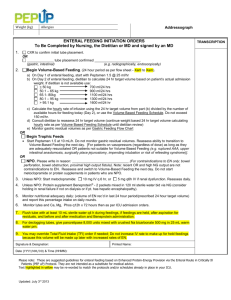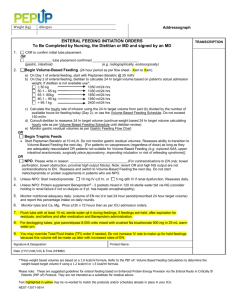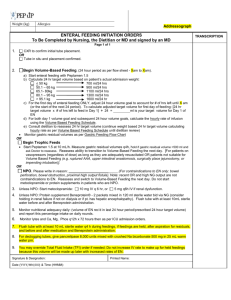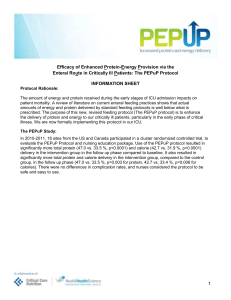Enteral feeds and procedures (surgery and extubation)
advertisement
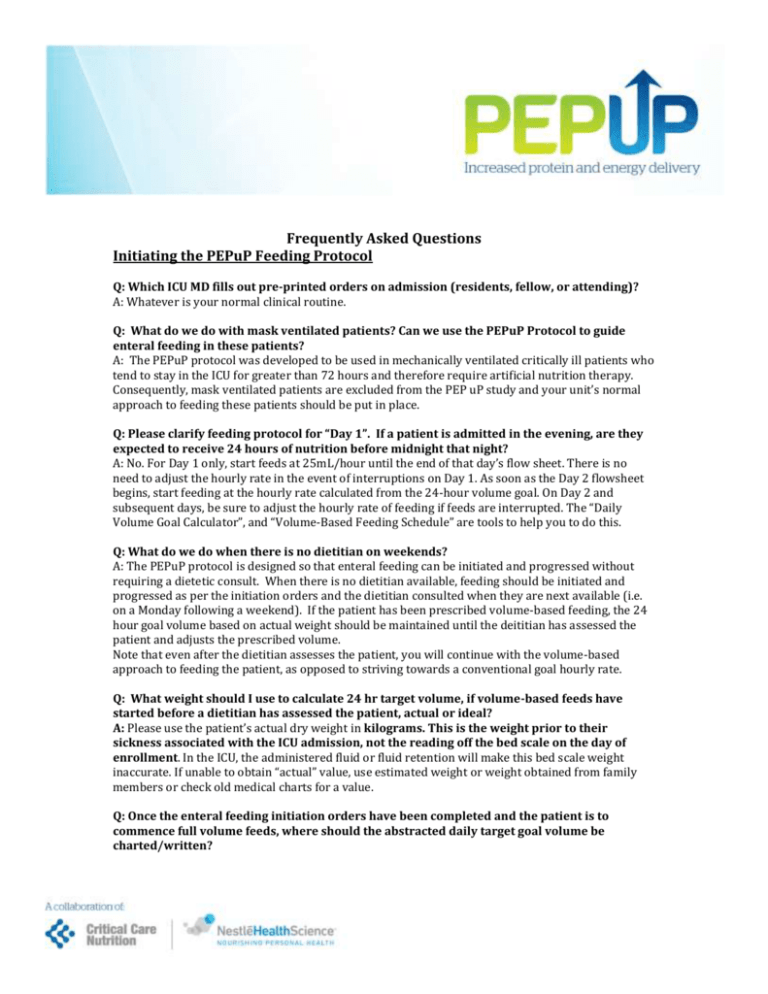
Frequently Asked Questions Initiating the PEPuP Feeding Protocol Q: Which ICU MD fills out pre-printed orders on admission (residents, fellow, or attending)? A: Whatever is your normal clinical routine. Q: What do we do with mask ventilated patients? Can we use the PEPuP Protocol to guide enteral feeding in these patients? A: The PEPuP protocol was developed to be used in mechanically ventilated critically ill patients who tend to stay in the ICU for greater than 72 hours and therefore require artificial nutrition therapy. Consequently, mask ventilated patients are excluded from the PEP uP study and your unit’s normal approach to feeding these patients should be put in place. Q: Please clarify feeding protocol for “Day 1”. If a patient is admitted in the evening, are they expected to receive 24 hours of nutrition before midnight that night? A: No. For Day 1 only, start feeds at 25mL/hour until the end of that day’s flow sheet. There is no need to adjust the hourly rate in the event of interruptions on Day 1. As soon as the Day 2 flowsheet begins, start feeding at the hourly rate calculated from the 24-hour volume goal. On Day 2 and subsequent days, be sure to adjust the hourly rate of feeding if feeds are interrupted. The “Daily Volume Goal Calculator”, and “Volume-Based Feeding Schedule” are tools to help you to do this. Q: What do we do when there is no dietitian on weekends? A: The PEPuP protocol is designed so that enteral feeding can be initiated and progressed without requiring a dietetic consult. When there is no dietitian available, feeding should be initiated and progressed as per the initiation orders and the dietitian consulted when they are next available (i.e. on a Monday following a weekend). If the patient has been prescribed volume-based feeding, the 24 hour goal volume based on actual weight should be maintained until the deititian has assessed the patient and adjusts the prescribed volume. Note that even after the dietitian assesses the patient, you will continue with the volume-based approach to feeding the patient, as opposed to striving towards a conventional goal hourly rate. Q: What weight should I use to calculate 24 hr target volume, if volume-based feeds have started before a dietitian has assessed the patient, actual or ideal? A: Please use the patient’s actual dry weight in kilograms. This is the weight prior to their sickness associated with the ICU admission, not the reading off the bed scale on the day of enrollment. In the ICU, the administered fluid or fluid retention will make this bed scale weight inaccurate. If unable to obtain “actual” value, use estimated weight or weight obtained from family members or check old medical charts for a value. Q: Once the enteral feeding initiation orders have been completed and the patient is to commence full volume feeds, where should the abstracted daily target goal volume be charted/written? A: Please document this figure in the location where the nurse would usually write the prescribed nutrition goal for the patient. This should be somewhere where it is easy for the nurse to refer to it, for example the nursing kardex, flow sheet, or in the patient chart. Q: What are the contraindications to motility agents and who will monitor this prior to starting the protocol? A: Same as contraindications to feeds. The intention is that the feeds, motility agents, protein supplements will be reviewed daily and determined if they are needed or need to be changed or discontinued. The PEP uP protocol is designed as a “safe start” strategy. 1-4 doses of a motility agent won’t do harm… they can be stopped the next day if not needed. Progression and Monitoring of Enteral Nutrition Q: Does the volume of feed delivered need to be cleared on the feeding pump and residuals checked every hour? A: No, do not clear the volume delivered on the feeding pump. The pump will indicate the volume delivered to the patient and will help you estimate the amount of feed remaining in the day to achieve the 24 hour goal volume. For patients on volume-based feeding or trophic feeding, gastric residual volumes should be checked every four hours. Q: Does the weight-based 24 hour target volume on the pre-printed orders remain the same on subsequent days? A: No. The 24 hour target volume is to be used to safely initiate feeds. However after feeds have started, this goal can be changed to whatever is deemed appropriate when the dietitian assesses the patient. Q: If the enteral formula is changed part way through the day, should I calculate the new rate based on the entire volume (24 hr) or just for the time remaining? A: The dietitian should include the volume of EN solution to be delivered in the remaining part of day and the amount to be delivered in the next 24 hr period on the order. Prescription should read: “Start (insert feeding formula) as per volume based protocol. Target volume until Xam = (insert target volume) 24 hr target volume to begin tomorrow at X am = _____ ml/day” If the target volume for the remaining hours left in the day is not provided, calculate the adjusted target volume: [24 hr target volume x # hrs left until end of flow sheet] 24 hrs. Q: If a patient is on trophic feeds, how frequently do I check the gastric residual volumes? A: If a patient is on trophic feeds, do not monitor gastric residual volumes. If the patient vomits or has abdominal distension, hold the feed and ask the physician to reassess the patient. Q: If a patient is on trophic feeds and feeding is interrupted for several hours at what rate do I restart the feeds? A: Restart the feed at 10ml/hr. There is no need to adjust the feeding rate to compensate for the interruption. Q: What should I do if a patient is receiving volume based feeding and I don't know how long feeds have been switched off? A: Refer to the I/O on the flow sheet and total the volume of enteral formula received since the start of the flow sheet. Subtract the volume received by the 24 hr target volume to determine the volume remaining. Calculate the number of hours left until the end of the flow sheet and refer to the Volume Based Feeding Schedule or excel rate calculator to determine the hourly rate. Q: I understand that by feeding the patient according to the PEP uP protocol that the volume of feeding ‘lost’ when the feed is on hold is ‘made up for’ when it is restarted. However, what do we do if there are very long interruptions (i.e. > 12 hours)? Should we start/increase IV fluids? A: There is no need to adjust IV fluids to account for day-to-day interruptions in feeding because the 24 hour goal volume will be provided using the PEP uP approach. However, in patients whose feeding status is changed to NPO for extended periods, please consult the clinical team to assess the need for additional fluids. The maximum rate permitted in patients receiving the volume based feeding is 150ml/hr and therefore on days where an interruption may exceed 12 hours the volume received may be less than 1200ml if the patient is receiving Peptamen 1.5. Q: How long do we continue the motility agents and protein supplements? A: The need for motility agents and protein supplements should be reviewed daily and the decision to discontinue, modify, or reinitiate should be made by the team at this time. Once the patient is receiving 100% of their protein requirements from enteral feeding, protein supplements can be stopped but should continue to be reviewed and restarted if the patients situation changes. Once the patient is tolerating the enteral nutrition with no high gastric residual volumes, the motility agents can be stopped. Q: The Gastric Feeding Flow Chart recommends considering adding erythromycin if patients continues to experience high GRVs after receiving metoclopramide. We do not use erythromycin in our ICU, what should we do? A: The recommended action steps included in the Gastric Feeding Flow Chart are merely suggestions on how to improve feeding tolerance. If you do not have erythromycin available but use an alternative prokinetic agent in your ICU, then consider adding this instead, or proceed to step 3 (small bowel tube placement). The most important point is that gastric intolerance is identified, reviewed by the team, and appropriate action taken. Q: The gastric residual volume threshold in our existing protocol is 400ml, which is higher than in the PEP uP Gastric Feeding Flow Chart. Should we reduce our threshold for the purposes of the PEP uP study? A: No, if your ICUs usual GRV threshold is greater than 300ml, please retain your usual threshold. Please revise the PEP uP Gastric Feeding Flow Chart accordingly. Miscellaneous Q: Do we monitor gastric residual volumes when the NPO option is selected? A: No, there is no need to monitor GRVs in patients who are NPO for the purpose of the PEP uP study. However, if monitoring GRVs in patients who are NPO is standard practice in your ICU you should continue with this practice. Q: Does the 24-hour target volume include the 10ml sterile water flushes and protein supplement given during feeding? A: No, the 24-hour target volume refers only to the volume of enteral formula to be delivered on that day and does not include the volume given as water flushes or with the protein supplement, these other fluids are delivered in addition to the 24-hour target volume of formula. Q: When using the PEP uP Protocol, is Peptamen 1.5 the only feed a patient can receive? A: Patients should start on Peptamen 1.5, however this formula can be changed when the patient is assessed by the dietitian. This formula was chosen because it is a calorically dense semi-elemental formula. Semi-elemental formulas are thought to be better tolerated in some patients, making them an ideal “safe start” formula until the dietitian can assess the patient. If you cannot get Peptamen 1.5 in your ICU, you may use a different semi-elemental formula as your “safe start” formula instead. Q: We use liquid protein supplements in our ICU, not powder supplements. Is this okay? A: Yes, it is okay to use a liquid protein supplement in place of a powder supplement. The goal is to provide approximately 12g of protein per day over 2-3 doses. Q: Our tube flushing and declogging protocol differs to what is on the initiation orders, what do we do? A: Anything highlighted in yellow on the enteral feeding order sheet can be adjusted to fit what you currently practice in your ICU. This includes tube flushing and declogging protocols. It is okay, for example, to use tap water instead of sterile water to flush feeding tubes, if this is standard practice in your ICU.
